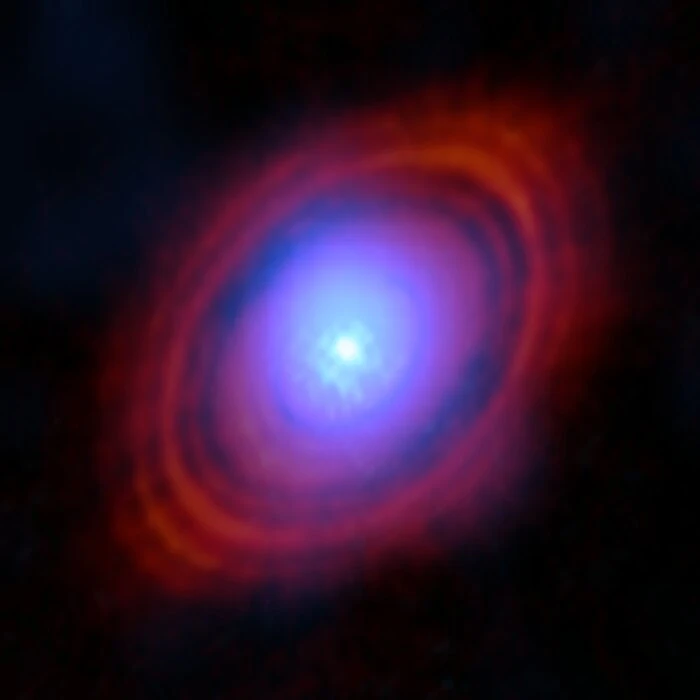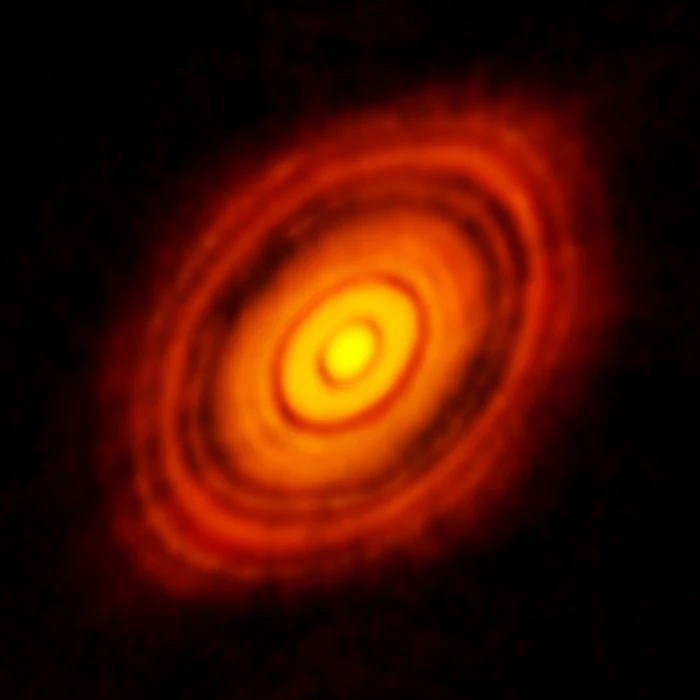Astronomers using the Atacama Large Millimeter/submillimeter Array (ALMA) have discovered vast reservoirs of water vapor in the disc around HL Tauri, a young star 450 light-years away from Earth, unveiling processes that may lead to the birth of planets rich in water and redefining our search for life in the universe.
An international group of researchers unveiled findings that have profound implications for our understanding of planet formation and the potential for life elsewhere in the universe.
Utilizing the powerful Atacama Large Millimeter/submillimeter Array (ALMA), in which the European Southern Observatory (ESO) plays a key role, scientists have detected vast quantities of water vapor within a disc surrounding a young star, specifically in regions where planets are likely taking shape.



Credit:
ALMA (ESO/NAOJ/NRAO)
This discovery, led by Stefano Facchini, an astronomer at the University of Milan, Italy, and recently published in Nature Astronomy, marks the first time water distribution has been mapped in a stable, cool disc.
Such discs provide the most conducive environments for planet formation around stars. Facchini expressed his astonishment at the findings, stating, “I had never imagined that we could capture an image of oceans of water vapor in the same region where a planet is likely forming.”
The young Sun-like star, HL Tauri, located about 450 light-years away in the constellation Taurus, is at the center of the new study.
The observations revealed that the inner disc of HL Tauri harbors at least three times the amount of water found in all of Earth’s oceans. Leonardo Testi, an astronomer at the University of Bologna, Italy, and co-author of the study, highlighted the exceptional nature of these “spatially resolved” observations, which allow astronomers to pinpoint water distribution across different regions of the disc.
A significant concentration of water vapor was discovered within a known gap in the HL Tauri disc. These ring-shaped gaps, often carved by orbiting young planetary bodies as they accumulate material and grow, are critical areas for planet formation. The presence of water vapor in such a gap suggests that it could play a crucial role in the chemical composition of forming planets.
The challenge of observing water with ground-based telescopes, given the interference caused by Earth’s own water vapor, makes this discovery all the more remarkable. ALMA’s location in the high, dry Atacama Desert at an elevation of approximately 5 km (3.1 miles) is instrumental in minimizing atmospheric degradation and ensuring exceptional observing conditions. According to co-author Wouter Vlemmings, a professor at the Chalmers University of Technology in Sweden, ALMA is currently the only facility capable of resolving water in a cool, planet-forming disc.
The study provided insights into the conditions that may facilitate the development of planetary systems elsewhere in the universe. As Elizabeth Humphreys, an astronomer at ESO and participant in the study, points out, the findings illustrate how water molecules are released from icy dust particles within the disc.
This process is believed to enhance the efficiency of planet formation, echoing the conditions that likely existed in our own Solar System approximately 4.5 billion years ago.
With ongoing upgrades to ALMA and the forthcoming operation of ESO’s Extremely Large Telescope (ELT), our understanding of planet formation and the critical role of water is set to expand significantly. The Mid-infrared ELT Imager and Spectrograph (METIS), for example, will offer astronomers unparalleled views of the inner regions of planet-forming discs, where terrestrial planets like Earth emerge.
References:
1 Resolved ALMA observations of water in the inner astronomical units of the HL Tau disk – Facchini, S., Testi, L., Humphreys, E. et al. – Nature Astronomy – February 29, 2024 – doi:10.1038/s41550-024-02207-w
2 Astronomers reveal a new link between water and planet formation – ESO – February 29, 2024
Featured image: The region in which HL Tauri is situated. HL Tauri is part of one of the closest star-forming regions to Earth and there are many young stars, as well as clouds of dust, in its vicinity. This picture was created from images forming part of the Digitized Sky Survey 2. Credit: ESO/Digitized Sky Survey 2
Study confirms no risk of asteroid Apophis being redirected toward Earth by other asteroids
Wednesday, March 6, 2024
Study reveals complete picture of anomalous heating in the Sun’s upper atmosphere
Tuesday, March 5, 2024
Extreme anticyclonic anomaly linked to catastrophic rainfall in Henan and marine heatwave
Monday, February 26, 2024
Advanced modeling uncovers seamounts as the source of Japan’s tsunami earthquakes
Sunday, February 18, 2024
New EQFL metric evaluates the impact of earthquakes on countries over the past five centuries
Sunday, February 18, 2024
Impacts of energetic particle precipitation (aurora borealis) on winter weather variations
Sunday, February 18, 2024
Unique aluminum-copper alloy quasicrystals found in Mount Gariglione meteorite
Saturday, February 17, 2024

